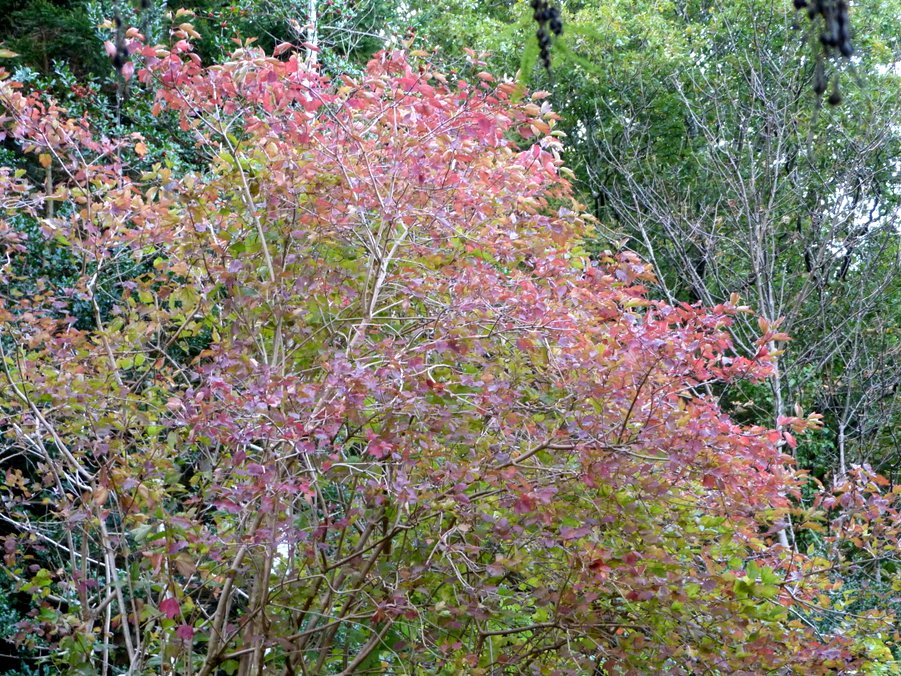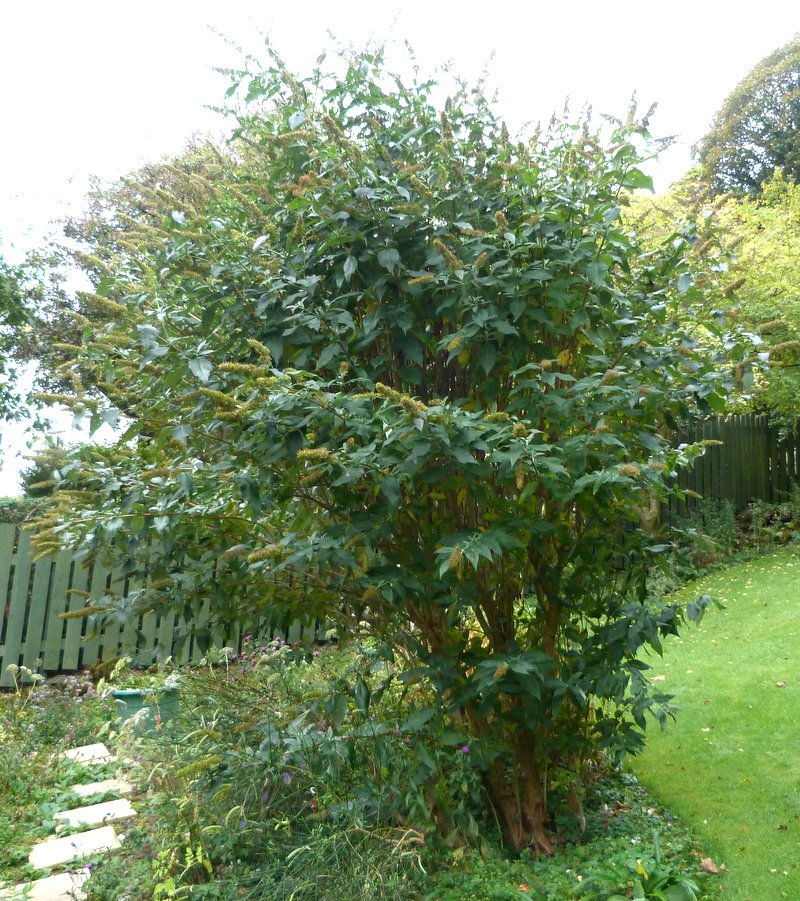Clearing and yet more clearing.
Sunday 25th October, 2015.
Wednesday morning: If all goes according to plan this will be a short week - as far as the blog is concerned, anyway. I am going to make a determined effort to get back to writing new posts during the weekend even when photos are few and far between.
It was dark and drizzly when I got up just before seven. It may remain drizzly but at least the mornings will be lighter next week after summer time ends and the clocks go back an hour. We revert to GMT during the early hours of Sunday morning. This reminds me of a silly running joke on a comedy radio show in South Africa. It was broadcast in the olden days before political correctness was invented and was called “Snoektown Calling”. It featured a spoof news bulletin which was read in an ethnic Cape accent and was always introduced by the line “The time is six o’clock Greenwich. Meantime here is the news.”
Our gardening news is that I continued with the clearing under the hawthorns in the afternoon but only managed to cut two muck buckets of old weeds, etc.
Thursday: Another dry day and yet more clearing in the back garden. True to form, I kept changing from one area to another.
I started under the plum tree and came across a bumblebee clinging to a stem of hedge woundwort which I had just cut. At first I thought it was dead but it waved a leg at me - so I took it down to the house and it posed for a photo session.
I wasted a lot of time trying to make a positive identification of the bumblebee which was either Bombus lucorum (white-tailed) or Bombus terrestris (buff-tailed). To complicate the issue, the males of both species have white tails. And to complicate the issue even further there is contradictory information on the internet. One site said that buff-tailed bees are only seen until the end of August. This led me to believe that it might be a white-tailed bumblebee because they were supposed to be around until November. But this theory was scuppered by another website which said that the buff-tailed bumblebees fly from June to October in Northumberland. And yet another site claimed that in the south of England - in areas where there is a suitable micro-climate, and gardens with winter-flowering shrubs - the buff-tailed colonies can be active throughout winter. There was even a report in 2008 which mentioned that an over-wintering colony had been seen in the Wildlife Garden at the Natural History Museum in London.
I am almost certain that my bumblebee is a buff-tailed male. It looked too small to be a female and the hairs on the tail look mainly white with a buff edge and it has black hairs on its face.
I read a very useful article on which bits of a bumblebees anatomy are important for photographic identification - but unfortunately I only read it after I had taken the photos. Another way of telling a male from a female bumblebee is to examine the femur of the back leg - the males have sparse hairs because they don’t have a pollen basket. I obviously spent far too much time focusing on his face instead of his hind leg and hairy behind.
Then I left him in a Welsh poppy in case he fancied some pollen.
While I was searching for bumblebee ID information, I came across an explanation for the loud buzzing by the bee which I saw on another Welsh poppy last week. Apparently the buzzing is a deliberate tactic to create a vibration which causes the flowers to release pollen.
The only other incident of minor interest in the morning was finding that our red toadstools were upside down. I wasted some more time trying to work out whether they had been blown over by the strong overnight wind or felled by a slug eating through the stem. My final decision was that they had been blown over after the stems had been partly severed by a slug.
I managed to cut four muck buckets of old vegetation so that we will have a full load to drive to the tip before shopping tomorrow morning.
Friday: There were short periods of light drizzly rain in the morning but it was mostly dry. During a sunny spell and I saw a speckled wood butterfly fluttering around by the “waterfall”. It sunbathed on a chunk of quartz for a while but didn’t stay for long.
Now the raspberry canes and ferns have been trimmed, I have a good view of the top of the waterfall from the study window. There is only a trickle of water at present and it is a favourite place for the little birds to land for a drink. I must clean the back windows soon so that I can take some more bird photos.
I decided to rest on yesterday’s laurels and have a break from clearing the garden. It isn’t very cold but the strong wind makes it rather unpleasant for working outside. The forecast for tonight is rather alarming:
Friday, 23 October 2015
Weather: Cloudy, some patchy rain possible at times, turning more persistent evening and heavy overnight
Wind: S-SW 20-25 increasing 25-35 perhaps 40
Visibility: Moderate/good occasionally poor later, hill fog
Temperature: Min. Air 8°C and Max. Air 14°C
Rainfall (mm): 10-20 (30-40 over high ground)
Comments: Strong wind/gales developing. Heavy Rain tonight may cause some localized flooding especially where drains become blocked with fallen leaves
Saturday: There wasn’t quite as much rain as we expected last night but there was enough to make the garden rather slushy. I decided to cut back a couple of muck buckets of ferns on the wildflower bank where the water runs off quickly.
Later I prowled around looking for things to photograph. There wasn’t much but I found some autumn colours. The viburnum in the back garden is looking quite colourful.
The foliage looked even brighter when I stood under the shrub and the sun shone through the leaves.
The view across the glen is also more interesting than usual with some of the broadleaf trees below the conifers changing colour. Most of the larches were felled a few years ago but they missed some at the edge of the plantation. Their golden needles stand out against the evergreen conifers at this time of year. Our big holly down by the road managed to sneak into the lower left corner of the photo. It has a good crop of berries this year.
I am puzzled by the fact that our lace-cap hydrangeas are going spotty as they fade. I can’t remember whether they have done this on previous years.
Sunday: I went up to the top of our garden to chase a trespassing black and white cat and noticed that I had forgotten to clear up the last bits of holly that I cut in the top of our neighbour’s garden a couple of weeks ago. So I went over with a tarpaulin and tidied up.
Then it was back to our garden to cut the last of the ferns on the wildflower bank. Another two muck buckets full today. I think I will try to maintain this quota. Going on about buckets of weeds and ferns isn’t exactly fascinating but I feel that it may help me motivate myself if I write down my targets and record my progress. I want to finish clearing the daffodil and snowdrop beds by the end of this month.
Instead of a another photo of the garden, here is one taken from the garden (or from our front patio to be exact) of the moon. The island is a great place for star-gazing when it isn’t covered with cloud or hill fog because there is very little light pollution. But I still find it incredible that my little camera can capture an image of the craters on the moon.
























































